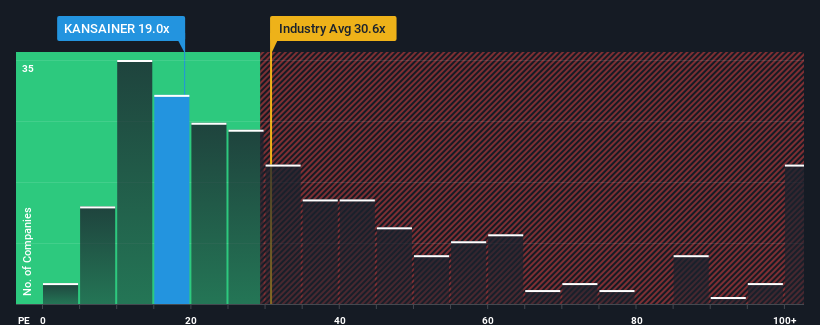Stock Analysis
Benign Growth For Kansai Nerolac Paints Limited (NSE:KANSAINER) Underpins Its Share Price

Kansai Nerolac Paints Limited's (NSE:KANSAINER) price-to-earnings (or "P/E") ratio of 19x might make it look like a buy right now compared to the market in India, where around half of the companies have P/E ratios above 32x and even P/E's above 58x are quite common. Nonetheless, we'd need to dig a little deeper to determine if there is a rational basis for the reduced P/E.
Kansai Nerolac Paints certainly has been doing a good job lately as it's been growing earnings more than most other companies. One possibility is that the P/E is low because investors think this strong earnings performance might be less impressive moving forward. If you like the company, you'd be hoping this isn't the case so that you could potentially pick up some stock while it's out of favour.
Check out our latest analysis for Kansai Nerolac Paints

How Is Kansai Nerolac Paints' Growth Trending?
Kansai Nerolac Paints' P/E ratio would be typical for a company that's only expected to deliver limited growth, and importantly, perform worse than the market.
Retrospectively, the last year delivered an exceptional 187% gain to the company's bottom line. The strong recent performance means it was also able to grow EPS by 146% in total over the last three years. Accordingly, shareholders would have probably welcomed those medium-term rates of earnings growth.
Shifting to the future, estimates from the seven analysts covering the company suggest earnings growth is heading into negative territory, declining 34% over the next year. Meanwhile, the broader market is forecast to expand by 24%, which paints a poor picture.
With this information, we are not surprised that Kansai Nerolac Paints is trading at a P/E lower than the market. Nonetheless, there's no guarantee the P/E has reached a floor yet with earnings going in reverse. There's potential for the P/E to fall to even lower levels if the company doesn't improve its profitability.
The Final Word
While the price-to-earnings ratio shouldn't be the defining factor in whether you buy a stock or not, it's quite a capable barometer of earnings expectations.
We've established that Kansai Nerolac Paints maintains its low P/E on the weakness of its forecast for sliding earnings, as expected. At this stage investors feel the potential for an improvement in earnings isn't great enough to justify a higher P/E ratio. It's hard to see the share price rising strongly in the near future under these circumstances.
We don't want to rain on the parade too much, but we did also find 3 warning signs for Kansai Nerolac Paints (1 is a bit unpleasant!) that you need to be mindful of.
Of course, you might also be able to find a better stock than Kansai Nerolac Paints. So you may wish to see this free collection of other companies that have reasonable P/E ratios and have grown earnings strongly.
Valuation is complex, but we're helping make it simple.
Find out whether Kansai Nerolac Paints is potentially over or undervalued by checking out our comprehensive analysis, which includes fair value estimates, risks and warnings, dividends, insider transactions and financial health.
View the Free AnalysisHave feedback on this article? Concerned about the content? Get in touch with us directly. Alternatively, email editorial-team (at) simplywallst.com.
This article by Simply Wall St is general in nature. We provide commentary based on historical data and analyst forecasts only using an unbiased methodology and our articles are not intended to be financial advice. It does not constitute a recommendation to buy or sell any stock, and does not take account of your objectives, or your financial situation. We aim to bring you long-term focused analysis driven by fundamental data. Note that our analysis may not factor in the latest price-sensitive company announcements or qualitative material. Simply Wall St has no position in any stocks mentioned.
About NSEI:KANSAINER
Kansai Nerolac Paints
Kansai Nerolac Paints Limited manufactures and supplies paints and varnishes, enamels, and lacquers in India.
Solid track record with excellent balance sheet and pays a dividend.

